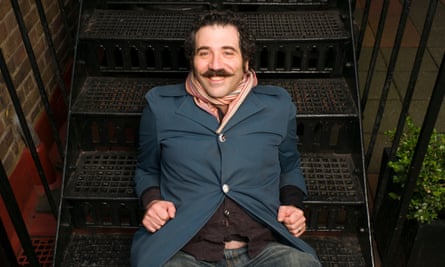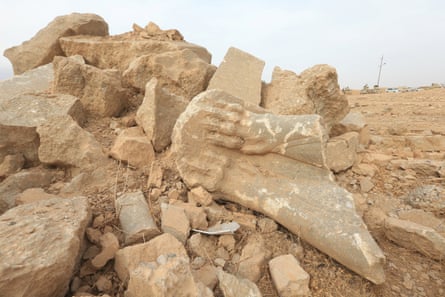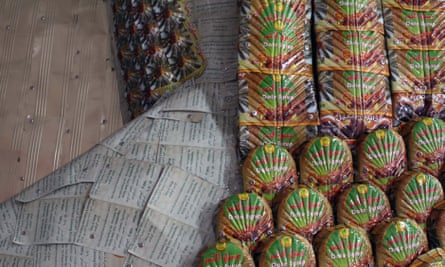In February 2015, Isis militants videoed themselves drilling the face off one of the commanding stone statues that had guarded the gates of the ancient city of Nineveh for more than a thousand years. The lamassu – winged bulls with serene human faces – were among the most monumental casualties of a spree of destruction that over just a few days reduced many of Iraq’s most precious artefacts to pebbles.
On 28 March, 2018, the life-sized “ghost” of one of these fabulous Assyrian creatures will be unveiled atop the fourth plinth in London’s Trafalgar Square, where it will stand with its back to the National Gallery, gazing south-east past the Foreign Office and the Houses of Parliament towards its spiritual home in the Middle East.
The 14ft-long statue is both a one-off statement and part of an ambitious long-term project by Michael Rakowitz, a 44-year-old Iraqi-American who has become one of the world’s most political – and powerful – artist-provocateurs. The aim of The Invisible Enemy Should Not Exist is no less than to reconstruct all 7,000 objects known to have been looted from the National Museum of Iraq in the aftermath of the 2003 invasion by the US-led coalition.

The idea was born as Rakowitz watched flickering green images of surgical strikes on Baghdad by the coalition – the invisible enemy – shortly after which the looting began. Until that moment, the suffering of the Iraqi people had been objectified, he explains. This was “the first moment of pathos, in that it didn’t matter if you were for or against the war, we could all agree that this was a catastrophe. It wasn’t simply a local Iraqi loss but one for the whole of humanity.”
However, this pathos didn’t play out as expected. “As the artefacts disappeared, I was waiting for the loss to translate into outrage and grief for lost lives, but it didn’t happen. So I had the idea of these lost artefacts coming back as ghosts to haunt us.”
The aim was not to replicate the looted objects, but to make them cheaply from papier mache or plaster and cover them with food packaging or Arabic newsprint to reflect their relationship with day-to-day life. The Trafalgar Square lamassu is “armoured” with brightly coloured tin from 10,500 cans of date syrup, which Rakowitz quality tested by nailing them to the walls of the Chicago house where he lives with his wife and two children, to see if they would fade or rust in a climate not so dissimilar to London’s.

Though he has never set foot in Iraq, Rakowitz is saturated in the culture of a country where his mother’s family lived until 1946 when, fearing for their safety as Arab Jews in an increasingly divided region, his grandfather made the decision to move them to the US, continuing to run his import-export business from New York.
From there, a generation on, they watched in horror as – in his mother’s words – the country they had escaped to invaded the one from which they had escaped. The start of the Iraqi looting coincided with Rakowitz’s own development, in his late 20s, from an artist who worked mainly in public spaces to one who was part of the gallery system. “When you get involved with galleries you have to come to terms with the thought that you’ve made something that’s going to be sold; and at the same time all these artefacts were being put up for sale.”
He became addicted to eBay (“It’s like a search engine for me”), on one occasion buying 18 of Saddam Hussein’s dinner plates from a US veteran and a refugee whose father had been a high-ranking soldier in the Iraqi army. The plates were to feature in one of his more mischievous works, Spoils (2011), in which he persuaded a Manhattan restaurant to use them to serve an Iraqi dish of venison and date syrup.
The project was halted after two months when the restaurant received a cease-and-desist letter from the US Department of State. The plates were confiscated and returned to Iraq in a diplomatic deal that he says was brokered by Barack Obama. “He was meeting with Nouri al-Maliki, so it was a ceremonial handover – a photo op … these 18 plates, which were a symbol of Saddam, going back on the plane of the Iraqi prime minister.”
Rakowitz insists he is not interested in controversy or spectacle but concedes that his work asks difficult questions. “I think discomfort is important. I describe the work I’m involved in as a process where problem-solving is also troublemaking.”
Food has always played an important part in it. In the ongoing Enemy Kitchen, he serves meals based on his mother’s family recipes to school students, and from a food truck staffed by Iraqi refugees as chief chefs with American Iraq War veterans as sous chefs and servers.
Return involved setting up a store in Brooklyn, like the one his grandfather used to run, but dedicated to the importation of dates. His first tonne of fruit was despatched overland, only to be held up at the sweltering Jordan border for so long that they cooked and had to be destroyed.

A second, smaller consignment of 10 boxes did finally make it through, after a month in quarantine. This proved to his highly sceptical export partners that “bad business can be good art”, while underlining the plight of refugees attempting to make the same journey and simultaneously pointing to the environmental catastrophe in the second half of the 20th century that led to the destruction of what was once Iraq’s second biggest export, after oil. “The date was to Iraq what the cigar was to Cuba and wine was to France,” he says. Six hundred varieties on 30m trees were decimated by war and disease.
Though Rakowitz’s work is always ultimately serious, humour is a key ingredient, along with his obsession with pop culture. Among the projects this combination has produced is a 10-part radio series, broadcast in Palestine, which mapped the rise of pan-Arabism against the simultaneous decline of the Beatles, and a letter to Leonard Cohen – written on Cohen’s own typewriter – which pegged a meditation on Jewishness to the singer’s controversial decision to perform in Israel during the 1973 Yom Kippur war and again in Tel Aviv in 2009, leading to the cancellation of a Ramallah show which was due to be part of the same tour.

Cohen never replied to the letter, and Rakowitz is not sure it ever reached him. “The letter was an artwork in itself, and I think of it like a drawing because I’m using the same tool he used to make these beautiful songs,” he says. “I wrote that boycotts are tragic but that I’d never shown in Israel. And what if I was going to sing his songs in Palestine? His words have a profound effect, and he had a huge fanbase in Ramallah that would have welcomed him with open arms.”
The typewriter was another of Rakowitz’s eBay treasures, bought from a Berlin collector, as was one of the more surreal exhibits in his 2010 Tate Modern show – his highest profile UK appearance to date – which made mind-boggling connections between Saddam Hussein’s regime and the Star Wars movies that obsessed him as a child. An Iraqi army helmet, advertised by a US army veteran, revealed that Saddam and his son Uday shared his obsession – to the extent of casting the Fedayeen helmets directly from the one worn by Darth Vader.
The list of Rakowitz’s antics, his fortuitous connections, seems as inexhaustible as his underlying moral seriousness. He once rerouted the ventilation pipes of a Chinese bakery in New York so that the smell permeated a nearby art opening – a playful intervention that linked to an ongoing project, which began in 1998 when he was still a student, to use ventilation pipes to blow warm air into custom-made inflatable shelters for homeless people.
He has so far made more than 70 of what he calls paraSITEs in New York, Baltimore, Boston and Chicago, constructing them from rubbish bags and duct tape, with instruction manuals circulated in street magazines. Might they follow the lamassu to London? Very few cities are ever willing to host them, he says, “because they make the homeless visible”.
They survived in some cases simply because the police turned a blind eye, realising that – as well as drawing attention to the growing problem of a population who, for whatever reason, had been “left behind by capitalism” – they also provided a practical solution to that problem. “Basically,” he says, “they’re better than blankets.”
- This item was amended on 28 March, 2018, to add the word Assyrian.
